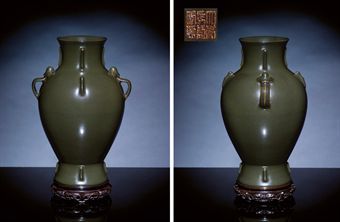A fine and extremely rare 'black' teadust glazed vase. Qianlong incised six-character sealmark and of the period (1736-1795)
A fine and extremely rare 'black' teadust glazed vase. Qianlong incised six-character sealmark and of the period (1736-1795)
Of archaic bronze form, the ovoid body flanked by a pair of ribbed 'C'-shaped handles surmounted by ruyi heads, between a pair of raised flanges at the shoulder, the flared neck and splayed foot each encircled with four further relief moulded flanges, covered overall in an even lush unctuous glaze of deep, moss-green tone, 13 in. (32.5 cm.) high, stand, three Japanese wood boxes. Estimate on request - Price Realized HK$11,860,000 ($1,537,615)
清乾隆 茶葉末釉如意耳出戟橄欖瓶 六字篆書刻款
在1933年雙軒庵的拍賣目錄中,著名學者上田恭輔對此瓶作出了詳細的探討。他在文章中寫道,此瓶為仿古樣式,並相信所有茶葉末釉瓶均為仿古青銅器而作。此瓶的釉色偏黑,像是仿青銅器上的銅鏽色。傳世品中如此深色的茶葉末釉非常罕見,為茶葉末釉瓷中之佳作。
傳世品中於此瓶相同的茶葉末釉瓶未有所見,唯一件釉色偏黃的2008年5月27日於香港拍賣,拍品1591號。
此器來源顯赫,曾分別為日本著名收藏家松本重太郎松下幸之助所藏。
松本重太郎 (1844-1913),號雙軒庵,明治時期關西著名企業家及藝術品收藏家。他創立日本第百三十銀行、南海鐵路及山陽鐵道。他和兒子松本枩蔵一起建立了一批著名的收藏。
松下幸之助 (1894 – 1989),是日本著名跨國企業「松下電器」的創始人,被人稱為「經營之神」、「事業部」、「終身僱傭制」、「年功序列」等日本企業的管理制度都由他首創。1979年創立財團法人「松下政經塾」,以培養日本國家領導人著稱。
Provenance: The So Ken Un collection, property belonging to Mr. Jyutaro Matsumoto, the owner of the Kyushu Electric Railroad Company
Konosuke Matsushita (1894-1989)
Literature: Tokyo Bijutsu Club auction catalogue for the So Ken An collection, 1933, lot 206 (sold for Yen 19,000)
Kyoto National Museum, The Special Exhibition in Memory of the New Building, Catalogue 1967, no. 311
Exhibited: Kyoto National Museum, The Special Exhibition in Memory of the New Building, 1966
Notes: The present vase was previously in the So Ken Un collection. The name 'So Ken Un' was the pseudonym of Mr. Jyutaro Matsumoto (1844-1913), one of the most famous businessmen and art collectors in the Kansai region during Meiji Period (1868-1912). He founded and owned several companies including Dai Hyaku Sanjyu Bank, Nankai Electric Railway, and Sanyo Electric Railway. Together Mr. Jyutaro Matsumoto and his son, Mr. Kozo Matsumoto formed a remarkable and renowned collection.
In the 1933 auction catalogue entry for the So Ken Un collection, renowned Japanese scholar Ueda Kyosuke, discussed this vase in detail. He refers to the vase as of hakuzan form (or archaic style) and writes that of all the teadust-glazed vases of bronze form, this vase is among the most pleasing. The glaze, he writes, is of kurosoba tone, literally 'black soba', in imitation of archaic bronze patina; dark, rich blackish-green teadust tone, this is the finest example.
The ownership of the vase was later transferred to Mr Konosuke Matsushita (1894-1989) who was the founder of Panasonic. He was one of the most admired managers in Japan and was often referred to as the "God of management". Mr Matsushita's management philosophy was widely adopted among Japanese enterprises and laid the foundation of economic growth in Japan. His influence also carried over into Japanese politics when he founded the Matsushita Seikei Jyuku (The Matsushita Institute of government and management) in 1980. The aim of this institute was to train young politicians and many of today's Japanese politicians carried out their studies at the prestigious Matsushita Institute.
Compare this vase with two other teadust vases of the same form, the first illustrated in Chinese Ceramics in the Idemitsu Collection, Tokyo, 1987, pl. 229; the other in the collection of Mr. Matsuzo Matsumoto, illustrated in Sokenan Bijutsu Shusei Zuroku, Kushu Denki Kido Gaisha, Japan, 1993, no. 206.
Compare also to a Ru-type vase of this elegant shape included in the exhibition held in Toyota prefecture, The Hirota Fukkosai Collection, Ceramics, Tokyo, 2007, fig. 169, now in the National Museum of Tokyo. A vase of this form, but of a much lighter golden olive-green colour was sold at Christie's Hong Kong, 27 May 2008, lot 1591.
Christie's. Important Chinese Ceramics and Works of Art. 1 December 2009. Hong Kong www.christies.com

/https%3A%2F%2Fprofilepics.canalblog.com%2Fprofilepics%2F1%2F0%2F100183.jpg)
/https%3A%2F%2Fstorage.canalblog.com%2F03%2F02%2F119589%2F96711876_o.jpg)
/https%3A%2F%2Fstorage.canalblog.com%2F11%2F31%2F119589%2F94773502_o.jpg)
/https%3A%2F%2Fstorage.canalblog.com%2F20%2F83%2F119589%2F94772815_o.jpg)
/https%3A%2F%2Fstorage.canalblog.com%2F26%2F72%2F119589%2F75604929_o.jpg)
/https%3A%2F%2Fstorage.canalblog.com%2F59%2F60%2F119589%2F26458628_o.jpg)



/http%3A%2F%2Fstorage.canalblog.com%2F88%2F76%2F577050%2F39455233_p.jpg)
/http%3A%2F%2Fstorage.canalblog.com%2F76%2F55%2F577050%2F39415583_p.jpg)
/image%2F1371349%2F20240418%2Fob_ac5c4c_telechargement.jpg)
/image%2F1371349%2F20240418%2Fob_709b64_304-1.jpg)